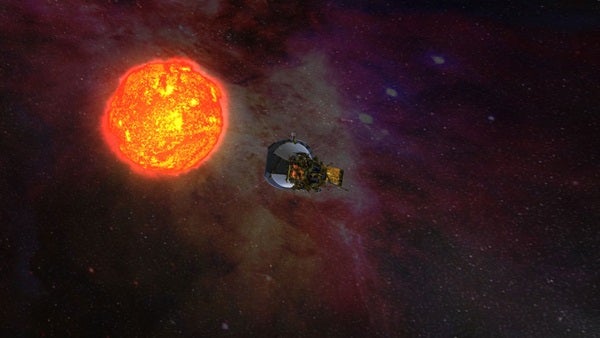A team led by the Johns Hopkins University Applied Physics Laboratory (APL), which has been developing the spacecraft for this extreme environment, has been given the nod from NASA to continue design work on the probe, building on the concepts it created during an initial design effort.
“Solar Probe Plus is an extraordinary mission of exploration, discovery, and deep understanding,” said Lika Guhathakurta from NASA Headquarters. “We cannot wait to get started with the next phase of development.”
After launch, slated for 2018, Solar Probe Plus will orbit the Sun 24 times, gradually moving in toward the Sun with each pass. The small car-sized spacecraft will zip through the Sun’s atmosphere as close as 4 million miles (6.4 million kilometers) from our star’s surface — exploring a region and facing conditions no other spacecraft has ever encountered.
The probe will include five science investigations specifically designed to solve two key questions of solar physics: Why is the Sun’s outer atmosphere so much hotter than the Sun’s visible surface, and what accelerates the solar wind that affects Earth and our solar system?
As the spacecraft approaches the Sun, its revolutionary carbon-carbon composite heat shield and other components must withstand temperatures exceeding 2550° Fahrenheit (1400° Celsius) and impacts from hypervelocity dust particles. Its science instruments will survey the most abundant particles in the solar wind — electrons, protons, and helium ions — and measure their properties; image the solar wind; measure the electric and magnetic fields, radio emissions, and shock waves that course through the Sun’s atmospheric plasma; and inventory the elements in the Sun’s atmosphere.
“Solar Probe Plus will be a historic mission, flying closer to the Sun than any previous spacecraft,” said Nicky Fox from APL. “Encountering the Sun’s atmosphere, or corona, for the first time, Solar Probe Plus will understand how the corona is heated and how the solar wind is accelerated. Solar Probe Plus will revolutionize our knowledge of the physics of the origin and evolution of the solar wind.”
In addition to the heat shield, the APL team will continue testing and developing other tricky aspects of spacecraft design. For example, engineers will build and test a flight-like active cooling system designed to keep the solar arrays at safe operating temperature throughout the orbit. Most spacecraft parts will be subjected to high-velocity dust tests that simulate the pelting they’ll face flying through swarms of high-energy particles near the Sun. “Solar Probe Plus presents technical challenges like no mission before it,” said Andrew Driesman from APL. “Over the next 26 months, our goal is to get these technologies to the point where we have full scale prototypes that we can test in a realistic environment.”










